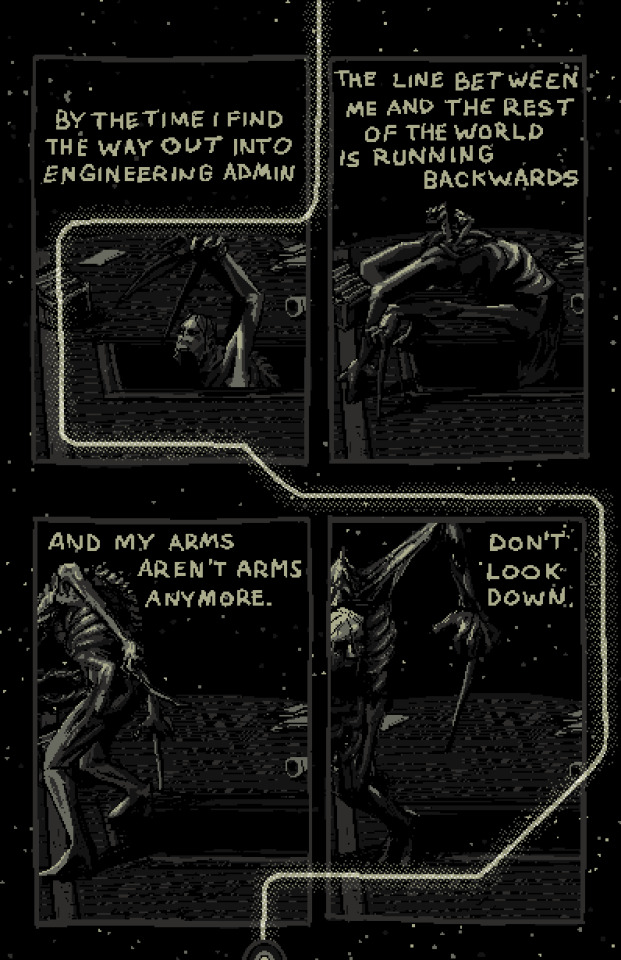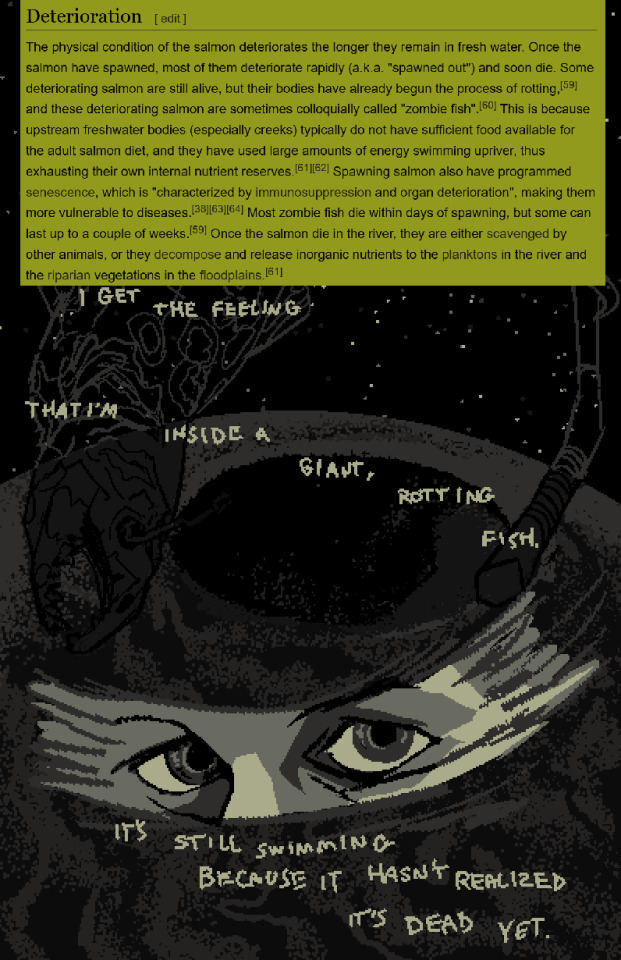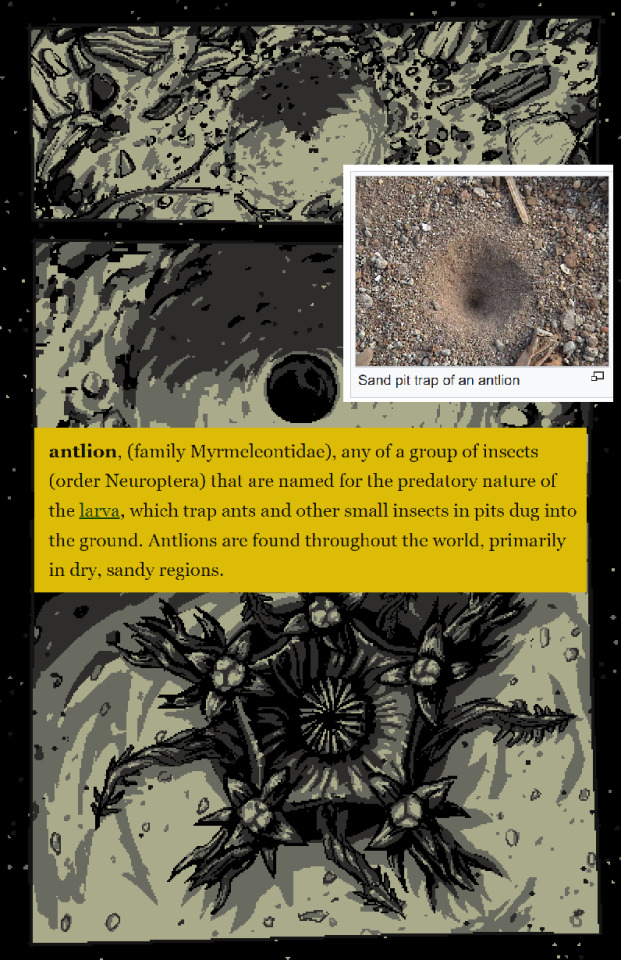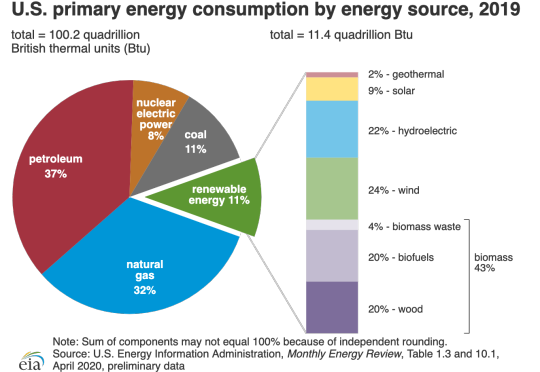#systems shutting down etc but also providing an essential part of the ecosystem while it gets eaten/decays from the inside out :)
Explore tagged Tumblr posts
Text












sometime between dead space (2023) and dead space 2, isaac recounts a dream where the line between the ishimura and isaac is blurred. was there ever a line to begin with?
the comic is up on itchio for free in PDF form + includes a bunch of in progress pics and extras (putting a few below the cut here :B). also my other dead space comic is up on itch as well!



#dead space#isaac clarke#cyrsed art#comics#i like the ishimura as a big rotting fish#systems shutting down etc but also providing an essential part of the ecosystem while it gets eaten/decays from the inside out :)#and idk about anyone else but the hive mind always reminds me of an antlion#not in appearance lol but being in that giant hole#anyway god this took a while!! i worked really hard on this!!#there's a bunch of details in here that took forever but probably dont' come across ghdlskfj#like all the graffiti on the wall#there's a dick that someone scratched off if you can find it lol#(tbh i don't think it's visible enough for people to see in the final product but it's there)#edit: i forgot to mention my headcanon is that isaac (and nicole) are big nerds about historical space ships#including the ishimura#9
386 notes
·
View notes
Link
Every year, I look for important themes in sustainability that will have lasting impact on society, from glaring evidence of global megatrends to inspiring stories of corporate action. The year 2018 brought extreme change — in weather and environmental ecosystems, in political winds and power, and in the expectations of business. It also brought incredible clarity about the scale of our challenges and opportunities.
So let’s start with the big picture before moving to some corporate success stories.
The world’s scientists sound a final alarm on climate
We have about 12 years left. That’s the clear message from a monumental studyfrom the Intergovernmental Panel on Climate Change (IPCC). To avoid some of the most devastating impacts of climate change, the world must slash carbon emissions by 45% by 2030, and completely decarbonize by 2050 (while, in the meantime, emissions are still rising).
The IPCC looked at the difference between the world “only” warming two degrees Celsius (3.8°F) — the agreed upon goal at global climate summits in Copenhagen and Paris — or holding warming to just 1.5 degrees. Even the latter, they say, will require a monumental effort “unprecedented in terms of scale.” We face serious problems either way, but every half degree matters a great deal in human, planetary, and economic losses.
It wasn’t just the IPCC that told a stark story. Thirteen U.S. government agencies issued the U.S. National Climate Assessment, which concluded that climate change could knock at least 10% off of GDP. Other studies tell us that sea level rise is going to be worse than we thought, Antarctica is melting three times faster than a decade ago, and Greenland is losing ice quickly as well. If both those ice sheets go, sea level rise could reach 200-plus feet, resulting in utter devastation, including the loss of the entire Atlantic seaboard (Boston, New York, D.C., etc.), all of Florida, London, Stockholm, Denmark, Uruguay and Paraguay, and land now inhabited by more than 1 billion Asians.
All of this suggests that business must dramatically change how it operates: companies will need to push well past their comfort zones from areas like politics and policy to engaging consumers to how they make investment decisions.
Entire towns are wiped off the map by extreme weather
This year the weather devastation around the world got, in the words of one colleague, “biblical.” The town of Paradise, California, was effectively eliminated by wildfires (that, yes, are made worse by climate change), killing at least 85 people. Most houses in Mexico Beach, Florida, were destroyed by Hurricane Michael. Unprecedented rains and damage from Hurricane Florence slammed North Carolina and temporarily turned a major highway into a river. Typhoon Mangkhut ravagedthe Philippines and parts of China, killing dozens of people. Incredible heat blanketed four continents this summer, with records falling across Europe and Asia. Venezuela’s last glacier is disappearing. Finally, Capetown, South Africa, is essentially out of water due in part to drought — the city nearly shut off all the taps this year, but has held off “Day Zero” through ongoing restrictions and aggressive citizen action.
The consequences of these extremes are not theoretical. What is the economic cost to an area with no water, or one that’s under water, or burned to the ground? In the U.S. alone, it was $306 billion in 2017, shattering records.
Coral is dying, insects are disappearing, and the fate of major ecosystems looks dim
The world’s top coral expert confirms that at 2 degrees of warming, all coral will die. This will destroy a critical part of an ocean system that provides protein to hundreds of millions of people, helps blunt coastal storm surges, and supports the livelihoods of people working in fishing and tourism.
And it’s not just coral: there’s the death of pacific kelp forests, radical declines in insect populations, and continuing population drops in all mammals and bees.
How does this all connect to business? For some sectors, it’s obvious: the food and agriculture industry will have trouble feeding us without pollinators, and tourism takes a big hit without coral and other wildlife. But more broadly, society will not thrive in a world where entire pillars of planetary support are collapsing. And if society can’t thrive, neither can business.
The U.S. environmental protection system continues being dismantled … from within
The EPA and Department of Interior are reversing years of protections for air, water, and land. In 2018, the Trump administration has opened up offshore waters and rolled back safety rules for drilling, greatly weakened the voice of science in policy, reduced focus on children’s health, and moved to make it easier to build dirty coal plants.
The big question now is whether businesses will push back and go down a cleaner path on their own. It’s easy to see why multinationals might as they face pressure from sub-national regions — California Gov. Jerry Brown held a Global Climate Action Summit which produced many aggressive climate goals from cities and state, for example. Gov. Brown also signed aggressive new laws committing to carbon-free electricity statewide by 2045 and requiring solar on all new homes. So even if U.S. action sputters, governors and mayors who influence local and regional business conditions will be pushing the clean economy and pro-climate agendas.
In pointed contrast to the U.S., the EU backed a proposal to strike no new trade deals with countries not in the Paris climate accord (i.e., only the U.S.), France will shut coal plants by 2021, India just cancelled plans for big coal plants, and China banned 500 inefficient models of cars.
A prominent leader retires, but new leaders step up
For nearly a decade, no business leader has done more to bring sustainability into the business mainstream than Paul Polman, Unilever’s outgoing CEO (Full disclosure: I’ve worked with Unilever). His depth of understanding of our biggest global, social, and environmental challenges, and his commitment to use business as a way to tackle them, has been unparalleled. But it wasn’t just talk. The company also grew throughout Polman’s tenure and the stock outperformed peers and the FTSE index. Luckily, there are other corporate leaders who are stepping up, including Danone’s Emmanuel Faber (see below for more).
But climate isn’t the only area where we’re seeing bold stances. Societal issues more broadly made headlines, too. The New York Times declared 2018 year that “CEO activism has become the new normal,” with prominent voices like Salesforce’s Marc Benioff leading the way. Other notable moments include Nike making Colin Kaepernick — the man who led NFL player protests about police violence against African Americans — the face of its 30th anniversary “Just Do It” campaign (sales rose quickly). Under pressure from survivors of school mass shootings, Dick’s Sporting Goods stopped selling assault weapons, and other companies cut ties to the powerful National Rifle Association. Kroger celebrated a year of its “End Hunger” initiative. Unilever threatened to pull its substantial ad dollars from Facebook and Google if they didn’t police “fake news and toxic content.” One hundred U.S. CEOs urged action on controversial immigration issues. And more than 100 U.S. companies gave employees time off to vote.
Danone North America becomes the world’s largest B Corporation
A “B Corp” certification requires answering an intensive set of questions on environmental, social, and governance issues. But most importantly, it commits a company to create value for all stakeholders (customers, employees, communities, and so on), not just shareholders.
French consumer products giant Danone has now put 30% of its brands and businesses through the certification process and says that “companies are fundamentally challenged as to whose interests they really serve.” Becoming a B Corp is arguably is a direct statement about whose interests it values most, and it’s and fascinating frontal attack on the dominance of shareholder capitalism.
More investors are viewing climate and sustainability as core value issues
Something is shifting in finance. Vanguard wants CEOs to be a force for good. Mark Carney, Governor of the Bank of England, said that “70% of [UK] banks, who normally have a shorter horizon, are viewing climate as a financial risk—not a CSR one.” Larry Fink, CEO of Blackrock, the world’s largest asset owner, encouraged longer-term thinking about environmental, social, and governance issues in a strongly-worded letter to large-company CEOs.
Anecdotally, I’ve talked to leaders at big banks who are now thinking differently about purpose and systemic risk. And in a quieter move, a major real estate investor in Miami began pulling money out of coastal assets to avoid risk of sea level rise. Watch this space.
The clean technology explosion continues and accelerates
Three big clean tech themes wowed me this year.
1) Renewables keep getting cheaper. According to Lazard’s annual analysis of the cost of building new power plants, renewables are now the cheapest. And another global analysis showed that new wind and solar are cheaper than one-third of the coal already on the grid — and will be cheaper than 96% of existing plants by 2030.
2) Corporate buying of clean energy keeps rising. By the end of just the first half of 2018, businesses bought more clean energy than they did in 2017. Companies like Owens Corning (disclosure: a client of mine) are buying enough green energy to pitch their products as cleanly manufactured (which they started doing in late 2017).
3) Electric vehicle sales are exploding, and it’s not just small vehicles: even container ships are going electric. UPS bought its first EV delivery vehicles at price parity to combustion engines, and China is adding nearly 10,000 electric buses to the roads — equal to the size of London’s entire bus fleet – every five weeks.
China rejects the world’s trash
For years, the U.S. had a great deal: When container ships arrived from China with goods, we sent them back filled with our recyclable paper and glass. But starting January 1, 2018, China stopped accepting our trash. The ripples of this move are unpredictable and still moving through the system, but in some regions, materials piled up and prices for recycled content plummeted. In a business world trying to go “circular” (i.e., find a use for everything and eliminate waste), it was a wake-up call about how much waste we still produce.
The battle against single-use plastic heats up, starting (somewhat oddly) with straws
Sometimes weird things hit a tipping point. For a combination of reasons, including a viral video showing a turtle with a straw stuck in its nose, companies waged war on straws this year. Marriott, McDonald’s, Starbucks, Burger King, and the city of Seattle, among others, all banned or are phasing out straws. It was a very small part of a larger conversation about “single-use plastics,” most notably plastic bags, which IKEA and Taiwan are banning as well.
Raising the bar for suppliers
The greening of the supply chain is a perennial story, but there are some noteworthy recent actions. Apple created a $300 million fund to help suppliers in China build more solar, and also partnered with Alcoa and Rio Tinto to develop a better smelting process to make carbon-free aluminum. On the labor side of the supply chain equation, PepsiCo and Nestle cut ties with a palm oil supplier over human rights abuses and Coca-Cola said it would work with the U.S. State Department to use blockchain to fight forced labor.
Meatless options grow plentiful
Given the way most cattle is currently raised, one of the most effective things an individual can do to reduce her carbon footprint is eat less meat. The options to do so are growing, and the rise of products made from non-animal proteins has been remarkable. The Impossible Burger, Beyond Meat, and other brands have made believers out of skeptics (they taste great) and are, as the Wall Street Journal put it, “overrunning grocery meat cases.” In another fascinating move, tech company WeWork went meat-free in its offices and even stopped reimbursing employees on business trips for meat meals.
What comes next…
I’m sure I missed many stories, especially globally (my view is from the U.S.). Predictions are hard, but I’m safe in assuming 2019 will be a bumpy ride again. Ultimately, today’s global political situation is, at best, unpredictable. Brazil now has a strongman-style leader who talks about cutting down the Amazon, but the U.S. just swung its House of Representatives back the other way, giving power to Democrats who want more focus on climate change, inequality, and other sustainability agenda items. No matter what happens politically, it seems clear that companies will continue to feel pressure, internally and externally, to do more on social and environmental issues. While the problems face we are extremely serious, I remain optimistic that companies will be doing more in 2019 than ever before.

46 notes
·
View notes
Text
Fueling the Modern World
The readings focus on nonrenewable and renewable energy sources, and they talk about the necessity to shift to new forms of energy production to prevent further climate change. Environmentally-degrading oil is the most widely used energy resource in the U.S. Fracking, another popular energy source, is also detrimental to the environment, costly, and limited. I enjoy how the textbook notes various issues with nonrenewable energy sources that are not restricted to the environment; this appeals to a diverse audience and provides a comprehensive view of the scope of the effects of degradation. In other words, environmental issues influence a range of other social and political issues, including foreign policy. Keith Crane explains this in his book Imported Oil and U.S. National Security, stating that a disruption in oil imports “would undermine U.S. national security, for example, by weakening U.S. global economic and political influence and the ability of the United States to pay for U.S. military forces” (Crane 2009, 19). The readings go on to present other sources of energy like oil and tar sands, which emit air pollutants and produce more CO2 than conventional crude oil production. Certainly, some new and seemingly promising energy solutions further damage the environment, and many methods of energy production have a high long-term cost. Although we can promote the view that these sources are detrimental to ecosystems as a whole, it may be more effective to focus on the human cost, which would attract a greater audience. Regardless of the angle one takes, it is integral that people look towards more ecologically friendly methods for sustainable and lasting solutions.
The textbook also covers natural gas and coal and explains how natural gas intensifies climate change and shifts people away from finding better energy because it is seen as clean. The description of coal highlights both the environmental and health issues caused by its mining and combustion. The health costs can be such an economic burden on countries that switching to cleaner energy can become the most viable option. Ben Ewald conducted a study in New South Wales, Australia on the health costs of SO2 emissions from burning coal (Ewald 2018, 227). Sulfate particles are classified as part of the particulate air pollution smaller than 2.5 microns (PM2.5). He found that by reducing PM2.5 levels 16%, there would be 104 fewer deaths and 560 fewer years of life lost per year in NSW, valued at about $539 million (based upon the statistical value of life) (Ewald 2018, 228). Ewald argues that pollution fees need to correspond with the cost of health damage to reduce emissions. Of course, speaking about human life in terms of money can be problematic, and it raises the question of why people cannot just value life for itself. Regardless, this tactic can expand the number of people in support of environmental action, including those who are more economically-driven. The production of CO2 by the coal industry causes further issues. By highlighting both the environmental and health impact of coal, the readers can understand how they are directly affected.
I always believed that nuclear energy was the key to the future, but the readings changed this. Although there are benefits to nuclear power like a low environmental impact and low accident risk, there are numerous disadvantages, such as the difficulty of disposing fuel rods, high cost, and low net energy production. However, governments have invested significantly more money into nuclear power than renewable resources, despite having little success. It makes me wonder what the world would look like if nations had focused on funding more sustainable options. Climate change may not be as advanced as it is now, and the U.S. could have been a leader in reducing emissions. According to a study in Risk Analysis, “Climate change concern is associated with increased acceptance of nuclear power only when nuclear power is considered as the only viable way to cut CO2 emissions” (Vainio et al. 2017, 557). Certainly, other options exist today that produce more energy and are better for the environment; therefore, nuclear energy and financement of it should be phased out.
Despite the higher net energy of nonrenewable resources, it is necessary to switch to renewable resources to reduce the environmental and health impacts. The readings highlight how by turning to cleaner options, we can create business opportunities and provide jobs, which is important because people often lean on the economy to justify ruining the environment. Indeed, it is integral to promote the positive economic effects and opportunities of businesses and countries becoming greener in order to generate more support for climate action. Consolidating diverse interests will be essential in fighting environmental degradation.
The U.S. needs to implement a smart grid to connect wind farms and solar power plants throughout the country, subsidize energy efficiency initiatives, and make the switch to more renewable energy. Generally, human systems are unnaturally linear, and in order to decrease human impact on the environment, people need to switch the energy system to one that imitates those found in nature (biomimicry). For example, solar cells mimic leaves, with some newer technology even turning to the sun as leaves do. Other renewable energy includes wind energy, which is highly productive and could potentially fuel the entire country. Loyola University Chicago created a program in which they collect oil from Chicago restaurants and universities and convert it into biodiesel that operates university and other local vehicles (Loyola University Chicago, n.d.). Small projects such as this one increase in their value when their methods are employed on a larger scale.
Of course, governments need to establish comprehensive policies to reduce pollution and increase renewable energy use, such as Corporate Average Fuel Economy (CAFE) standards, which improve vehicles’ fuel efficiencies. Standards are being used in Paris by establishing a low-emission zone where only certain vehicles can enter (Bernard et al.). This reduces air pollution and encourages people to purchase fuel-efficient and electric cars. Increasing CAFE standards in the coming years will further improve the energy efficiency of vehicles on the road.
We need to create legislation that forces communities to utilize renewable energy. California legislation requires the state to use renewable energy to produce half of its electric power by 2030. If this was imposed on a national level, we would see a sharp increase in wind, solar, and other renewable energy and a lower reliance on coal, oil, etc. Furthermore, the government needs to shift away from awarding subsidies and tax breaks to nonrenewable energy producers, and it should provide financial incentives for building and using renewable energy. Of course, these initiatives would be more logical if the U.S. government sped up the process of building a smart grid so widespread usage of clean energy would be more viable. Tax breaks and other economic incentives should also be used to encourage people to purchase more energy-efficient vehicles, including hybrid and electric cars.
The government must also implement full-cost pricing when it comes to nonrenewable resources to reduce their usage. The International Monetary Fund approximates that if full-cost pricing were applied to burning coal, coal use would drop 55%, and CO2 emissions would drop 20%. It is necessary that pricing accurately reflects human and environmental cost; in the case of the NSW study, taxes were not high enough to make any companies take action. However, if done properly, this method can greatly reduce emissions from burning coal and producing other forms of nonrenewable energy. Promoting environmental education in schools and through community groups is integral in combating the narrative that nonrenewable energy is safe, which is purported by many corporations.
Unfortunately, impoverished people bear the brunt of climate change much more than those who are well-off, and many suffer as a result of wealthier people’s actions, such as corporations. While the rich can flee the effects of environmental degradation, marginalized people must face them directly. This makes comprehensive environmental policy even more necessary, and it can ameliorate other race and class issues, such as health. More immediate policy can include building parks in urban areas and cleaning up pre-existing places. Grassroots organizations can also spearhead efforts, and the Bronx River Alliance is revitalizing the Bronx River, and their work has a multitude of psychological and physical benefits to nearby residents. Growing up, I had the opportunity to explore nature through clean parks, playgrounds, and more in my neighborhood. Just 20 minutes down the road in a more impoverished neighborhood, children did not have access to the same opportunities and did not live in a healthy environment. Today, the memories I made in nature were formative and continue to affect my relationship with the world. It is unfair that so many young people are denied these opportunities, just because of how much money their parents have, and action must be taken to prevent further injustices.
Changing building standards to ensure green architecture would reduce energy waste, use solar energy to heat buildings, and more. Unfortunately, living in a sustainable manner is largely only accessible to wealthier people who have the means to live in buildings with top-of-the-line technology. Therefore, by making green living more accessible to everyone with government subsidies, less energy will be wasted and less emissions will be produced, leading to a cleaner world for everyone. On an individual level, we can all take action in our homes by ensuring that leaky heating is sealed, using LED bulbs, shutting off electronics when not in use, and transitioning to energy-efficient appliances. Switching to a cleaner and more energy-efficient world is critical in preventing further climate change. Acting sustainably can be a difficult road to take, especially given the capitalist system that we live in. I find myself purchasing from Amazon instead of shopping at brick-and-mortar stores, and I often eat meat in favor of vegetarian and vegan options. However, we must all be more conscious of our actions and their effects in order to have a cleaner future, or even a future at all.
Word Count: 1668
Question: If governments had focused their resources on renewable energy rather than nuclear energy, how would current emissions have been affected?
Diagrams:

Savings due to reduced air pollution in New South Wales, Australia

Potential phases for Paris’ implementation of its low-emission zones: cars receive stickers based on their fuel-efficiency

Sources of U.S. energy in 2019 - very unsustainable
Works Cited:
Crane, Keith. 2009. Imported Oil and U.S. National Security. Santa Monica, CA: RAND Corporation. https://eds-a-ebscohost-com.avoserv2.library.fordham.edu/eds/detail/detail?vid=0&sid=c36b0d2f-45db-4a48-9f08-35b1ee8e70c8%40sdc-v-sessmgr02&bdata=JnNpdGU9ZWRzLWxpdmU%3d#AN=276729&db=e000xna.
Ewald, Ben. 2018. “The value of health damage due to sulphur dioxide emissions from coal- fired electricity generation in NSW and implications for pollution licences.” Australian and New Zealand Journal of Public Health 42, no. 3: 227-229. EBSCOhost.
Vainio, Annukka, Riikka Paloniemi, and Vilja Varho. 2017. “Weighing the Risks of Nuclear Energy and Climate Change: Trust in Different Information Sources, Perceived Risks, and Willingness to Pay for Alternatives to Nuclear Power.” Risk Analysis: An International Journal 37, no. 3. 557-569. EBSCOhost.
Bernard, Yoann, Joshua Miller, Sandra Wappelhorst, and Caleb Braun. 2020. “Impacts of the Paris low-emission zone and implications for other cities.” The Real Urban Emissions Initiative (March 2020): 5. https://theicct.org/sites/default/files/publications/Paris-LEV-implications-03.12.2020.pdf.
Loyola University Chicago. n.d.”Biodiesel Program.” https://www.luc.edu/media/lucedu/sustainability-new/pdfs/IES-biodiesel.pdf.
#environmental studies#environmentalism#clean energy#renewable energy#wind energy#solar energy#nuclear energy#biodiesel#fossil fuels#pollution
0 notes
Text
4 Mar 2020: Coronavirus. Insurance: Ford’s black box. Amazon goes big.
Hello, this is the Co-op Digital newsletter - it looks at what's happening in the internet/digital world and how it's relevant to the Co-op, to retail businesses, and most importantly to people, communities and society. Thank you for reading - send ideas and feedback to @rod on Twitter. Please tell a friend about it!

[Image: New Scientist/Alfred Pasieka/Science Photo Library]
Coronavirus: making supply networks visible
UK Government published its COVID-19 plan, which says that up to a fifth of UK workers could be off sick at any one time in the “reasonable worst case”. If that happens there will obviously be strain on systems: you’ll see
“population distancing strategies (such as school closures, encouraging greater home working, reducing the number of large-scale gatherings) to slow the spread of the disease throughout the population, while ensuring the country’s ability to continue to run as normally as possible.”
That might also mean key parts of the public sector need to prioritise the most essential services, so NHS, social care, emergency services etc may see some streamlining.
What are big tech firms doing? Amazon is banning non-essential travel. Twitter is encouraging staff to work from home and Google is trying out a work-from-home day in Ireland to test its preparedness. (Amazon is also trying to stop people selling face masks at hugely inflated prices on its platform.)
Very practically: it might seem suspiciously simple, but handwashing with soap is still the best thing to do, because soap is good at ripping apart the fatty envelope around the virus. Some measured “preparing” is probably sensible and helpful because it introduces a little slack into the health and food systems. The wider community benefits because the case load on the healthcare system is spread out over time the. (For the avoidance of doubt, this newsletter is *not* advising anyone to immediately put their camouflage bandana on and barricade themselves into their homes. And nor are public health experts, who are the people to actually listen to.)
It looks like the virus will make visible some of the things that modern life works hard to keep invisible. Critical national infrastructure - chief medical officers, scientists - explain the situation and the plan. And supply chains also become more visible: if consumer electronics become more expensive, you might get a sense of that supply chain reaching back to China. But it isn’t a single chain, a linear path of supply along which money is swapped for things. It’s really supply *networks* - all the supply chains are entwined. If schools are shut, then there will be knock-on effects: a significant percentage of the workforce would be at home looking after children. This also means that if you wanted to avoid other people by staying at home and getting everything safely delivered to your house, well that still relies on Amazon's delivery people! The virus may eventually force everyone to think at the level of the community, rather than the individual.
Elsewhere:
“GOV.UK Notify just helped an NHS team set up a 2-way text messaging service for extreme-risk people to monitor and report Coronavirus symptoms. Took them a few hours, start to finish. Would've been impossible, even a couple of years ago. This is why platforms matter.”
Azeem Azhar wonders if coronavirus will force some political, economic and cultural adaptation upon society.
Insurance: Ford’s black box
Ford will offer drivers better insurance rates in partnership with Nationwide (a US insurer, not the UK mortgage provider). Insurance premia depend on how much you use the car, but also how you use it - drivers will be able to get up to 40% off if they drive safely. It’s one of the first driving telemetry solutions that doesn’t need a “black box” to be installed - the car is the black box. The catch for drivers: you need to be happy sharing your driving data with Ford and your insurer, and no doubt you need to be a safe driver.
Also in car insurance:
Young drivers “let down over insurance app faults” - Carrot uses phone data to measure braking and acceleration, but some say it often fails to work.
How we analyzed Allstate’s car insurance algorithm - data + code = new approaches to journalism.
Amazon goes big
Amazon has opened its first full size cashierless grocery store in Seattle - Go technology at 5,000 product lines in 10,000 sq ft size. (And here’s someone’s inevitable “can we fool the sensors and steal a banana” piece.) You shouldn’t necessarily see this story as Amazon going bigger now that it has *perfected* Go. There will probably be many more experiments with technology, format, size, inventory, location and everything else. Amazon is the experiment machine.
Elsewhere in supermarkets:
Walmart's click-and-collect offering is doing well - 37% growth in US ecommerce (which covers both click-and-collect and delivered).
M&S Food will expand its fill-your-own-container scheme to Manchester after a successful trial in which half of the lines offered outsold their packaged equivalents.
Tesco puts 1,800 jobs at risk as it scales down in-store bakeries - on the other hand Waitrose is selling more bread!
Ridesharing: more pollution, more accidents
Two research reports find unexpected problems with ridesharing:
ridesharing companies seem to generate 70% more pollution than the trips they displace.
ridehailing is associated with an increase of approximately 3% in the number of fatalities and fatal accidents, for both vehicle occupants and pedestrians.
When your company started up in car culture’s home country, then naturally the solutions mostly look like… cars. Though this might be part of the problem.
Other news
Lloyds of London will insure crypto wallets - given the last decade of stories about cryptocurrencies and their wallets being hacked, you’d guess the premia will be quite big.
Kickstarter workers vote to form first union in US tech industry.
Amazon primed to change the fashion industry in new TV series - Amazon’s first big fashion TV-meets-shopping cross-selling project.
Here is your heart-warming retail story: Italian IKEA store opens its doors to local stray dogs.
Co-op Digital news and events
How the Web team used the ‘top tasks’ approach to prioritise.
Sign up for The Federation newsletter!
Public events, most of them at Federation House:
Global Legal Hackathon Manchester - Fri 6 - Sun 8 Mar 4pm.
Digital City Festival - Mon 9 - Fri 13 Mar at venues across Manchester, several of them at Federation house.
Open Data Manchester: Black software (explores racial injustice & the professionals & hobbyists of color who helped build the internet) - Wed 18 Mar 6.30pm.
Returners/Re-trainers (about successful initiatives to create better routes for women returners/re-trainers) - Thu 26 Mar 11.30am
Internal events:
Targeted Marketing (CRM) and Data Ecosystem show & tell - Wed 4 Mar 3pm at Angel Sq 13th floor breakout.
Membership show & tell - Fri 6 Mar 3pm at Fed 6 kitchen.
Delivery community of practice - Mon 9 Mar 1.30pm.
Co-operate show & tell - Wed 11 Mar 2pm at Angel Sq 8th floor red core breakout.
Data management show & tell - Thu 12 Mar 2.30pm at Angel Sq 13th floor breakout.
Membership show & tell - Fri 13 Mar 3pm at Fed 6 kitchen.
More events at Federation House - and you can contact the events team at [email protected]. And TechNW has a useful calendar of events happening in the North West.
Thank you for reading
Thank you, beloved readers and contributors. Please continue to send ideas, questions, corrections, improvements, etc to the newsletterbot’s typing entity @rod on Twitter. If you have enjoyed reading, please tell a friend!
If you want to find out more about Co-op Digital, follow us @CoopDigital on Twitter and read the Co-op Digital Blog. Previous newsletters.
0 notes
Text
Blog No. 6
The topics of this week’s readings were Environmental Economics, Politics, and Law. It may not be immediately evident, but most economic systems rely heavily on the environment, especially Capitalism when it comes to resources such as natural capital and raw material. Thus, environmental sustainability is in the best interest of even the world’s most carbon emitting corporate powers. In stark contrast, sustainable/green business is on the rise as corporations are becoming increasingly aware of the economic benefits of going green. A business is green if it makes the principle of sustainability a part of its business model from the services it provides to its day-to-day operations (Wikipedia 2019). I think one of the best ways to hold corporations accountable for damage to the environment is through carbon pricing which is what my internship this semester is all about. In essence, carbon pricing puts a price on emissions to not only hold companies responsible but encourage them to make the shift towards renewable energy. At first glance, sustainable business may sound like a costly enterprise; however, not only will it broaden a businesses’ market and consumer base, but, like homeowners, companies are often rewarded with tax breaks for conserving energy by installing things like solar panels and green roofs (Wikipedia 2019). A great example is the New School which recycles all of its water and employs smart electricity to mitigate how much it wastes during daily operations.
It's really important that we try to do away with these misconceptions that going green is more cost than it’s worth. For example, an Environmental News Network article maintains that “putting a price on carbon, in the form of a fee or tax on the use of fossil fuels, coupled with returning generated revenue to the public” would help to significantly curb emissions (ENN 2018). Although high carbon prices would likely cause massive backlash from some corporations, it would only serve to benefit the individual and might help in raising awareness that going green does not have to be expensive (ENN). In fact, there are many ways that people can curb their individual emissions and conserve without installing expensive solar panels or green stoves simply by unplugging devices, eating less meat, layering up in the winter instead of cranking the heat, etc. That said, there is also a misconception about solar panels, hydro-power, and Tesla’s awesome Powerwall, etc. that while they do have high upfront costs, there is actual legislation that ensures greater return. If people knew how much energy they waste per day by simply leaving the lights on I think they would be astonished. Pictured below is a graphic that demonstrates this to an even more disturbing extent; for example, 15 million tons of CO2 are emitted annually just for outdoorlighting such as lamp posts and to offset this would require roughly 600 million trees. I can’t even imagine what it is for indoor, non-automatic lighting. In short, we need greater tax incentives to encourage more people to go green, because evidently environmental ethics and compassion are not at the forefront of the collective American conscience (for the most part).

(IDA 2016)
In its chapter on environmental economics, Miller lays out the three kinds of resources that uphold economic systems, beginning with natural capital which is essential to not only economies but life on earth. The second kind is human capital which includes “labor, organizational and management skills, and innovation.” The last kind is manufacture capital which “refers to machinery, equipment, and factories made from natural resources with the help of human resources” (Miller 2012, 614). Everything boils down to natural resources, they provide sustenance to all forms of life which obviously includes the labor force. Manufacture capital also depends on natural resources such as water, iron ore, oil, etc. The article, The Value of The World’s Ecosystem Services and Natural Capital, explains that together, these three capitals make human welfare possible, both in regard to our survival and non-basic functions (Costanza et al., 1997, 254). The environment makes everything possible from climate regulation to our recreational activities. Thus, it is in the best interest of every economy, Capitalist or otherwise, to act environmentally conscious and strive to end climate change. There are the capitalist economies that rely on the buying of natural resources for production and the many non-capitalist economies that may rely on the selling of natural resources for revenue, both of which are jeopardized by climate change. The article makes the point that it is controversial to evaluate ecosystem services because some argue that “we cannot place a value on such ‘intangibles’ as human life, environmental aesthetics, or long-term ecological benefits” while others argue that “we should protect ecosystems for purely moral aesthetic reasons” and even others say that we “have a moral responsibility to prevent poverty by whatever means necessary” (Costanza et al., 1997, 255). Nonetheless, the article maintains that ecosystem valuation is necessary. Although controversial, I think these kinds of debates have helped to fuel really important laws and regulations such as the National Environmental Policy Act’s mandating of the “Environmental Impact Statement” that must be conducted for any federal or federal sponsored project that could impact the environment. Without this piece of legislation, any political figure or person with political support and enough money, connections, and power could get their project on the ground running.
Miller discusses the difference between internal (direct) and external (indirect) costs where the former includes the upfront and obvious factors such as labor and shipping that associate with the price of a product and the ladder refers to all of the environmental impacts that the production of our commodities have (Miller 2012, 621). Moreover, when I buy, for example, a new laptop, it's not immediately evident to me the myriad of factors that went into the production of this single commodity that in fact requires, for example, copious amounts of water for each component and emits tons of CO2 not only in its manufacturing but in the transportation of all the materials required for its production whether by plane, boat, etc. Because of this misconception, I think buzz words such as “eco-friendly” and “local” are really misleading. People think that they are doing the environment justice when they shop at Trader Joe's and Whole Foods because they seem progressive and liberal as far as grocery stores go when in reality, we have no idea the environmental impacts that these places have. In response to Miller’s Critical Thinking Question #9 from Chapter 23 that asks to list my five most important strategies for shifting to eco-economies over the next 50 years, my first strategy would be to implement greater incentives forshifting to eco-economies (Miller 2012, 635). This means better tax breaks, rebates and other benefits for businesses that yield a greater return on investment in things like renewable energy, water-recycling system in buildings, green roofs, etc. Next I would make renewable energy cheaper and this would be accomplished by the third strategy of carbon pricing and the revenue from that would go towards renewable energy production to drive down the price. The fourth strategy would be to shut down more coal power plants, perhaps as many as 70%, with the remaining 30% in less developed countries that may not have the funds to make the shift to renewable energy/eco-economy. The fifth and final strategy would be to replace the coal plants with renewable energy plants which would ultimately create more green jobs.
Environmental Politics is another essential discipline for protecting the environment and holding people accountable for environmental negligence. Environmental Politics plays an important role in protecting “environmental and public interests, and [encouraging] more environmentally sustainable development” (Miller 2012, 638). Another component of this is environmental law which addresses everything from air quality to hunting. Although environmental laws have been enacted as early as the 19th century, they had more to do with public health and waste management than the natural environment. In fact, environmental law as we know it today did not popularize in the United States until the mid 20th century, which is also around the time that Nixon created the EPA (Wikipedia 2019). Environmental laws specifically “help to control pollution, set safety standards, encourage resource conservation, and protect species and ecosystems” (Miller 638). I am becoming increasingly aware of how important federal law is in keeping states in check and overriding state laws that may not favor environmental protection. For example, in my “Conservation Law and Policy” course we just finished briefing a case where, on account of the Supremacy Clause of the constitution which gives federal agencies/laws precedence, the court held in favor of the federal environmental organization over the challenged state statute. It’s really important that federal law - when under the authority of a liberal, climate change recognizing, and environmentally compassionate administration - supersedes state laws, especially when it comes to traditionally right-wing states.
As aforementioned, NEPA is really important in evaluating and authorizing federal proposals and serves a symbol for democracy in that it mandates that all environmental impact statements be made available for public comment (Miller 2012, 650). Fortunately, in its relationship to environmental economics, environmental politics helps to correct market failures having to do with the environment (Prof’s Powerpoint). Unfortunately, politicians are often lobbied and swayed to vote against for certain environmental bills by powerful corporations who may not have the environment’s best interest in mind. Moreover, as discussed in “Consumer or Citizen,” politicians often take advantage of consumerism in soliciting votes and support. The piece distinguishes between the two, where a model consumer is someone who strives to maximize their own satisfaction and are more influenced by the economy and being a “good American” than by morals and virtues. In essence, profiting off of the idea that to be a real American and general member of society one must contribute to the economy. “In contrast, the ideal citizen takes ‘a moral point of view,’ by perceiving herself as one equal member among many engaged in cooperative activity for mutual advantage, i.e. a ‘community’” (Partridge 2002). This contrast is partly a result of the partizanization of environmental issues that not only has divided politicians but people in general who may feel that caring about the environment goes against their political values. For example, Donald Trump’s promise to bolster the economy by revitalizing the coal industry and bringing back coal jobs even though A) the industry is in decline not only because it wreaks havoc on the environment but because renewable energy is simply more profitable and B) the renewable energy industry is growing rapidly and creating more jobs than any other industry including coal, despite Trump’s claim that it’s a bad investment (DiChristopher and Schoen, 2018). I would also argue that the consumer is likely to be less concerned with their duty to future generations or the current generation and instead adopt the attitude that whatever they do in favor or against the environment won’t make a difference as they are simply a drop in the ocean of billions of other consumers.
Word count: 1841
Discussion Question: Do you think federal environmental agencies should be allotted more power and involvement in the economy and corporate world in their mission to protect the nature and the environment such as through greater carbon prices and stricter regulations.
Work Cited
Miller, Tyler G., and Scott Spoolman. "Chapter 23: Economics, Environment, and Sustainability." Edited by Scott Spoolman. In Living in the Environment. 17th ed. Belmont, CA: Brooks/Cole, Cengage Learning, 2012.
Costanza, Robert, Ralph D'Arge, Rudolf De Groot, and Stephen Farber. "The Value of the World's Ecosystem Services and Natural Capital." Nature 387(March 15, 1997).
"Sustainable Business." Wikipedia. January 27, 2019. https://en.wikipedia.org/wiki/Sustainable_business.
Van Buren, Edward. “Prof’s PowerPoint Notes.” https://drive.google.com/file/d/0BzKbjVLpnX0RMjVGYUwwZlBXa28/view
Partridge, Ernest. "Consumer or Citizen?" Price of Progress. April 2002. http://gadfly.igc.org/politics/left/consumer.htm.
Miller, Tyler G., and Scott Spoolman. "Chapter 24: Politics, Environment, and Sustainability." Edited by Scott Spoolman. In Living in the Environment. 17th ed. Belmont, CA: Brooks/Cole, Cengage Learning, 2012.
"Environmental Law." Wikipedia. February 05, 2019. https://en.wikipedia.org/wiki/Environmental_law.
Massachusetts Institute of Technology. "Carbon Taxes Could Make Significant Dent in Climate Change, Study Finds." Environmental News Network. April 06, 2018. https://www.enn.com/articles/54283-carbon-taxes-could-make-significant-dent-in-climate-change-study-finds.
"The International Dark-Sky Association (IDA)." International Dark-Sky Association. July 19, 2016. https://www.darksky.org/light-pollution/energy-waste/.
DiChristopher, Tom, and John W. Schoen. "Trump Says 'the Coal Industry Is Back.' The Government's Jobs Numbers Say Otherwise." CNBC. August 23, 2018. Accessed February 18, 2019. https://www.cnbc.com/2018/08/23/trump-says-the-coal-industry-is-back-the-data-say-otherwise.html.
0 notes
Text
Condition Monitoring Crucial to Industry 4.0
The world is now at the dawn of fourth industrial revolution or better known as Industry 4.0 – the transition from computerized systems to cyber-physical systems, enabled by technologies like the Internet of Things, Cloud computing and Artificial Intelligence.
In the strictest sense, Industry 4.0 is the integration of new technologies into the current industrial processes, essentially creating intelligent networks, wherein intelligent machine-to-machine interactions become the norm. For instance, machines in the assembly line can be made intelligent enough to monitor and predict failures that can in turn autonomously trigger maintenance procedures.
Although, the scenario where automation and AI take over the world seems overblown and is unlikely for the distant future, it is highly likely that interlinking machines will soon be the next big thing in the manufacturing sector. Following are the key components that define an industrial ecosystem as industry 4.0:
Interoperability
This refers to the capability of machines, sensors, devices and people to communicate and share information.
Information transparency
Information transparency is defined as the capability of systems to aggregate data obtained from the physical world into a virtual copy.
Technical assistance
Technical assistance refers to a system’s ability to assist humans in solving problems and in making decisions, while also being able to physically assist humans in certain tasks.
Decentralized decisions
Decentralized decisions refer to a system’s ability to take its own decisions, essentially, employing AI to perform the task with minimal human interference.
However, there are various challenges involved in the transition to Industry 4.0; such as ensuring data security and a high degree of reliability in cyber-physical systems, avoiding loss of jobs due to automation etc. Besides, in order to improve the availability of machines by preventing downtimes, maintenance services become of prime importance in the manufacturing sector. Therefore, changing to Industry 4.0 also means that an upgrade in the existing maintenance operations is a necessity.
Currently, Preventive Maintenance (PM) is the widely adopted strategy for conducting maintenance. It essentially means scheduling maintenance at regular intervals of time – while the machine is still in working condition – to avoid the development of any major fault. Today, vehicles, appliances, machines etc., are mostly serviced by adopting Preventive Maintenance strategies. For the Industry 4.0, this is not sufficient, since the underlying reason to incorporate technology into existing processes,among many others, is to improve efficiency and reliability of operations, to be cost-effective and to grow businesses. Preventive Maintenance does not offer these due to the following reasons:
PM is not cost effective
As it is time-based, therefore requires maintenance to be scheduled at regular periods of time, it particularly inflates the cost incurred, if maintenance is done prematurely.
PM requires large resource investment
With regular maintenance, entities need to invest in more spare parts. This can again inflate cost if maintenance is not properly planned.
Unplanned downtimes cannot be avoided
Although PM can largely avoid unanticipated downtimes due to regular maintenance, in the event of an unexpected downtime, it becomes a drain on time as well as resources.
PM is labor intensive
PM is often performed on equipment that is in fully working condition, causing unnecessary downtime in attending to the equipment, and investing unneeded labor. Besides, due to PM being labor intensive, maintenance staff needs to be trained on a regular basis as well, which is costly and highly inconvenient considering that manufacturers strive for maximum resource productivity.
Manufacturers are increasingly implementing Industry 4.0 technologies to make their operations smart, and Condition Monitoring is emerging as a disruptive solution to proactive, cost-efficient, and timely maintenance.
Condition Monitoring
Condition Monitoring is a component of Predictive Maintenance. As suggestive of its name, Predictive Maintenance, unlike Preventive Maintenance, relies on the condition of a machine rather than a schedule that is set at regular intervals.
Condition Monitoring refers to monitoring certain parameters of a machine to identify the development of any fault at early stages. For instance, currently with the Preventive Maintenance strategy, a vehicle is required to be serviced once it has travelled a certain distance, say 15,000 kilometers; this is done regardless of the vehicle’s condition, which sometimes may be unnecessary. On the contrary, with Condition Monitoring, vehicle servicing may be done at 12,000 kilometers or 20,000 kilometers, depending solely on its condition, which therefore brings many added advantages.
The relevance of Condition Monitoring in Industry 4.0
The rise of Industry 4.0 technology provides the opportunity for dramatically increasing the reliability and efficiency in production operations. Condition Monitoring solutions, from the likes of Microsoft, Seebo and IBM promise to ease the transition to industry 4.0.
To bring clarity regarding the way Condition Monitoring helps, a brief overview of how a paper mill in Germany utilizes the strategy to bring it a step closer to Industry 4.0 would prove helpful. Mitsubishi HiTec Paper Europe produces thermographic papers, that are coated using modern methods at its factory units in Germany. Their challenge was to maintain large high-speed fans used for drying the coating, from causing imbalance due to its mass and ultimately resulting in plant shut down. To solve this, a solution that comprised of systems that could continuously monitor vibrations from the fans was devised. On employing a Condition Monitoring maintenance strategy, they were able to identify gradually developing faults such as irregularities in flotation dryers. This early identification enabled them to schedule maintenance quickly and they were able to plan downtimes needed for servicing, ultimately increasing machine availability and reducing overall operating costs.
As seen above, Condition Monitoring is a crucial component of Industry 4.0 and following are some the major benefits it offers:
Decrease in unplanned downtimes
Decrease in labor costs
Increased machine availability and process reliability
Improved work safety
Estimated 8% to 12% cost savings over Preventive Maintenance
There are many other advantages besides these when considering Industry 4.0, the major one being that it paves the way for easier adoption of smart solutions.
Conclusion
While a good majority of industries are still caught up between the traditional assembly line and small-scale implementation of automated processes, transition to Industry 4.0 becomes a great challenge. However, to catch up with the fiercely competitive markets, industries need to look for solutions that can make their transition to 4.0 quick, without affecting their performance. Condition Monitoring is one such solution that can ease this transition and pave the way for the adoption of Industry 4.0.
https://ift.tt/2JzO6M6
0 notes
Text
Condition Monitoring Crucial to Industry 4.0
The world is now at the dawn of fourth industrial revolution or better known as Industry 4.0 – the transition from computerized systems to cyber-physical systems, enabled by technologies like the Internet of Things, Cloud computing and Artificial Intelligence.
In the strictest sense, Industry 4.0 is the integration of new technologies into the current industrial processes, essentially creating intelligent networks, wherein intelligent machine-to-machine interactions become the norm. For instance, machines in the assembly line can be made intelligent enough to monitor and predict failures that can in turn autonomously trigger maintenance procedures.
Although, the scenario where automation and AI take over the world seems overblown and is unlikely for the distant future, it is highly likely that interlinking machines will soon be the next big thing in the manufacturing sector. Following are the key components that define an industrial ecosystem as industry 4.0:
Interoperability
This refers to the capability of machines, sensors, devices and people to communicate and share information.
Information transparency
Information transparency is defined as the capability of systems to aggregate data obtained from the physical world into a virtual copy.
Technical assistance
Technical assistance refers to a system’s ability to assist humans in solving problems and in making decisions, while also being able to physically assist humans in certain tasks.
Decentralized decisions
Decentralized decisions refer to a system’s ability to take its own decisions, essentially, employing AI to perform the task with minimal human interference.
However, there are various challenges involved in the transition to Industry 4.0; such as ensuring data security and a high degree of reliability in cyber-physical systems, avoiding loss of jobs due to automation etc. Besides, in order to improve the availability of machines by preventing downtimes, maintenance services become of prime importance in the manufacturing sector. Therefore, changing to Industry 4.0 also means that an upgrade in the existing maintenance operations is a necessity.
Currently, Preventive Maintenance (PM) is the widely adopted strategy for conducting maintenance. It essentially means scheduling maintenance at regular intervals of time – while the machine is still in working condition – to avoid the development of any major fault. Today, vehicles, appliances, machines etc., are mostly serviced by adopting Preventive Maintenance strategies. For the Industry 4.0, this is not sufficient, since the underlying reason to incorporate technology into existing processes,among many others, is to improve efficiency and reliability of operations, to be cost-effective and to grow businesses. Preventive Maintenance does not offer these due to the following reasons:
PM is not cost effective
As it is time-based, therefore requires maintenance to be scheduled at regular periods of time, it particularly inflates the cost incurred, if maintenance is done prematurely.
PM requires large resource investment
With regular maintenance, entities need to invest in more spare parts. This can again inflate cost if maintenance is not properly planned.
Unplanned downtimes cannot be avoided
Although PM can largely avoid unanticipated downtimes due to regular maintenance, in the event of an unexpected downtime, it becomes a drain on time as well as resources.
PM is labor intensive
PM is often performed on equipment that is in fully working condition, causing unnecessary downtime in attending to the equipment, and investing unneeded labor. Besides, due to PM being labor intensive, maintenance staff needs to be trained on a regular basis as well, which is costly and highly inconvenient considering that manufacturers strive for maximum resource productivity.
Manufacturers are increasingly implementing Industry 4.0 technologies to make their operations smart, and Condition Monitoring is emerging as a disruptive solution to proactive, cost-efficient, and timely maintenance.
Condition Monitoring
Condition Monitoring is a component of Predictive Maintenance. As suggestive of its name, Predictive Maintenance, unlike Preventive Maintenance, relies on the condition of a machine rather than a schedule that is set at regular intervals.
Condition Monitoring refers to monitoring certain parameters of a machine to identify the development of any fault at early stages. For instance, currently with the Preventive Maintenance strategy, a vehicle is required to be serviced once it has travelled a certain distance, say 15,000 kilometers; this is done regardless of the vehicle’s condition, which sometimes may be unnecessary. On the contrary, with Condition Monitoring, vehicle servicing may be done at 12,000 kilometers or 20,000 kilometers, depending solely on its condition, which therefore brings many added advantages.
The relevance of Condition Monitoring in Industry 4.0
The rise of Industry 4.0 technology provides the opportunity for dramatically increasing the reliability and efficiency in production operations. Condition Monitoring solutions, from the likes of Microsoft, Seebo and IBM promise to ease the transition to industry 4.0.
To bring clarity regarding the way Condition Monitoring helps, a brief overview of how a paper mill in Germany utilizes the strategy to bring it a step closer to Industry 4.0 would prove helpful. Mitsubishi HiTec Paper Europe produces thermographic papers, that are coated using modern methods at its factory units in Germany. Their challenge was to maintain large high-speed fans used for drying the coating, from causing imbalance due to its mass and ultimately resulting in plant shut down. To solve this, a solution that comprised of systems that could continuously monitor vibrations from the fans was devised. On employing a Condition Monitoring maintenance strategy, they were able to identify gradually developing faults such as irregularities in flotation dryers. This early identification enabled them to schedule maintenance quickly and they were able to plan downtimes needed for servicing, ultimately increasing machine availability and reducing overall operating costs.
As seen above, Condition Monitoring is a crucial component of Industry 4.0 and following are some the major benefits it offers:
Decrease in unplanned downtimes
Decrease in labor costs
Increased machine availability and process reliability
Improved work safety
Estimated 8% to 12% cost savings over Preventive Maintenance
There are many other advantages besides these when considering Industry 4.0, the major one being that it paves the way for easier adoption of smart solutions.
Conclusion
While a good majority of industries are still caught up between the traditional assembly line and small-scale implementation of automated processes, transition to Industry 4.0 becomes a great challenge. However, to catch up with the fiercely competitive markets, industries need to look for solutions that can make their transition to 4.0 quick, without affecting their performance. Condition Monitoring is one such solution that can ease this transition and pave the way for the adoption of Industry 4.0.
https://ift.tt/2JzO6M6
0 notes
Text
Condition Monitoring Crucial to Industry 4.0
The world is now at the dawn of fourth industrial revolution or better known as Industry 4.0 – the transition from computerized systems to cyber-physical systems, enabled by technologies like the Internet of Things, Cloud computing and Artificial Intelligence.
In the strictest sense, Industry 4.0 is the integration of new technologies into the current industrial processes, essentially creating intelligent networks, wherein intelligent machine-to-machine interactions become the norm. For instance, machines in the assembly line can be made intelligent enough to monitor and predict failures that can in turn autonomously trigger maintenance procedures.
Although, the scenario where automation and AI take over the world seems overblown and is unlikely for the distant future, it is highly likely that interlinking machines will soon be the next big thing in the manufacturing sector. Following are the key components that define an industrial ecosystem as industry 4.0:
Interoperability
This refers to the capability of machines, sensors, devices and people to communicate and share information.
Information transparency
Information transparency is defined as the capability of systems to aggregate data obtained from the physical world into a virtual copy.
Technical assistance
Technical assistance refers to a system’s ability to assist humans in solving problems and in making decisions, while also being able to physically assist humans in certain tasks.
Decentralized decisions
Decentralized decisions refer to a system’s ability to take its own decisions, essentially, employing AI to perform the task with minimal human interference.
However, there are various challenges involved in the transition to Industry 4.0; such as ensuring data security and a high degree of reliability in cyber-physical systems, avoiding loss of jobs due to automation etc. Besides, in order to improve the availability of machines by preventing downtimes, maintenance services become of prime importance in the manufacturing sector. Therefore, changing to Industry 4.0 also means that an upgrade in the existing maintenance operations is a necessity.
Currently, Preventive Maintenance (PM) is the widely adopted strategy for conducting maintenance. It essentially means scheduling maintenance at regular intervals of time – while the machine is still in working condition – to avoid the development of any major fault. Today, vehicles, appliances, machines etc., are mostly serviced by adopting Preventive Maintenance strategies. For the Industry 4.0, this is not sufficient, since the underlying reason to incorporate technology into existing processes,among many others, is to improve efficiency and reliability of operations, to be cost-effective and to grow businesses. Preventive Maintenance does not offer these due to the following reasons:
PM is not cost effective
As it is time-based, therefore requires maintenance to be scheduled at regular periods of time, it particularly inflates the cost incurred, if maintenance is done prematurely.
PM requires large resource investment
With regular maintenance, entities need to invest in more spare parts. This can again inflate cost if maintenance is not properly planned.
Unplanned downtimes cannot be avoided
Although PM can largely avoid unanticipated downtimes due to regular maintenance, in the event of an unexpected downtime, it becomes a drain on time as well as resources.
PM is labor intensive
PM is often performed on equipment that is in fully working condition, causing unnecessary downtime in attending to the equipment, and investing unneeded labor. Besides, due to PM being labor intensive, maintenance staff needs to be trained on a regular basis as well, which is costly and highly inconvenient considering that manufacturers strive for maximum resource productivity.
Manufacturers are increasingly implementing Industry 4.0 technologies to make their operations smart, and Condition Monitoring is emerging as a disruptive solution to proactive, cost-efficient, and timely maintenance.
Condition Monitoring
Condition Monitoring is a component of Predictive Maintenance. As suggestive of its name, Predictive Maintenance, unlike Preventive Maintenance, relies on the condition of a machine rather than a schedule that is set at regular intervals.
Condition Monitoring refers to monitoring certain parameters of a machine to identify the development of any fault at early stages. For instance, currently with the Preventive Maintenance strategy, a vehicle is required to be serviced once it has travelled a certain distance, say 15,000 kilometers; this is done regardless of the vehicle’s condition, which sometimes may be unnecessary. On the contrary, with Condition Monitoring, vehicle servicing may be done at 12,000 kilometers or 20,000 kilometers, depending solely on its condition, which therefore brings many added advantages.
The relevance of Condition Monitoring in Industry 4.0
The rise of Industry 4.0 technology provides the opportunity for dramatically increasing the reliability and efficiency in production operations. Condition Monitoring solutions, from the likes of Microsoft, Seebo and IBM promise to ease the transition to industry 4.0.
To bring clarity regarding the way Condition Monitoring helps, a brief overview of how a paper mill in Germany utilizes the strategy to bring it a step closer to Industry 4.0 would prove helpful. Mitsubishi HiTec Paper Europe produces thermographic papers, that are coated using modern methods at its factory units in Germany. Their challenge was to maintain large high-speed fans used for drying the coating, from causing imbalance due to its mass and ultimately resulting in plant shut down. To solve this, a solution that comprised of systems that could continuously monitor vibrations from the fans was devised. On employing a Condition Monitoring maintenance strategy, they were able to identify gradually developing faults such as irregularities in flotation dryers. This early identification enabled them to schedule maintenance quickly and they were able to plan downtimes needed for servicing, ultimately increasing machine availability and reducing overall operating costs.
As seen above, Condition Monitoring is a crucial component of Industry 4.0 and following are some the major benefits it offers:
Decrease in unplanned downtimes
Decrease in labor costs
Increased machine availability and process reliability
Improved work safety
Estimated 8% to 12% cost savings over Preventive Maintenance
There are many other advantages besides these when considering Industry 4.0, the major one being that it paves the way for easier adoption of smart solutions.
Conclusion
While a good majority of industries are still caught up between the traditional assembly line and small-scale implementation of automated processes, transition to Industry 4.0 becomes a great challenge. However, to catch up with the fiercely competitive markets, industries need to look for solutions that can make their transition to 4.0 quick, without affecting their performance. Condition Monitoring is one such solution that can ease this transition and pave the way for the adoption of Industry 4.0.
https://ift.tt/2JzO6M6
0 notes